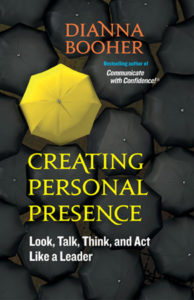


(Forbes first published my article here.)
No matter where your paycheck, profits, or clients come from, learning to give a good speech can increase your chances of success in your chosen occupation.
If you’re a corporate trainer, you’ll be presenting information, data, or exercises to a captive audience—and you definitely don’t want them to be bored and badmouth your classes.
If you’re a writer, your fans will ask you to speak about your book at their book clubs or at book signings.
If you’re a CEO or principal—whether large or small organization—you’ll be meeting with groups of strategic suppliers or client executives.
If you’re a star performer in your organization, either your boss will be sending you to speak at industry conferences or your colleagues will be inviting you to share your how-to’s to help them succeed.
Try a test run.
Step 1: Identify and select a topic or incident to talk about: a favorite movie, a horrendous customer service experience, the funniest prank someone pulled during your high-school or college days, or maybe an ongoing conflict you’ve been having with a family member or friend.
Step 2: In the privacy of your own home or conference room at work, tell the story aloud and record yourself on your iPhone (video record, not just audio).
Step 3: Review and analyze the recording. Did you use an engaging delivery style? Did you sound sincere, authentic, relaxed? Did you have high energy? Were you animated or too “low key” to keep someone’s attention?
Step 4: (optional) If you’re unsure about your self-analysis, ask a friend or colleague to listen to your recording.
Whether or not you like what you’ve recorded, you may want to “up your game” with the following seasoned-speaker secrets:
We all hear a lot today about authenticity and sincerity. Well and good. Always be authentically yourself. But most of us are authentically different “selves” on different occasions with different people.
For example, with our kids or grandkids at McDonalds for hamburgers, we dress, speak, and gesture in a different way than we dress, speak, and gesture at a wedding reception. We tailor our word choices, tone of voice, gestures, posture, and movements according to the audience and occasion.
Never be low energy or boring when you simply intend to be casual or informal in your presentation.
So as a public speaker, present your best self for each specific audience and occasion.
Rather than use familiar, repetitive gestures, make your gestures match your ideas.
Gestures paint a word picture as you speak. They also reinforce key ideas. Your gestures help listeners visualize what you’re describing. With a simple gesture or two, you can give the audience a hint of the original scene or situation, and the listener’s mind will fill in the rest. Their senses will expand their experience to make your point memorable.
Remember also: The larger the room, the larger your gestures should be to include your audience. To increase your presence, lift your arms from the shoulder and move your arms outward from the trunk of your body rather than inward toward your body (unless, of course, you’re referring to yourself as you speak). Such large, smooth-flowing gestures convey your openness to the group and give you a larger-than-life presence.
Never pace back and forth, wandering around the stage area aimlessly. Plant your feet. Make a point. Then move to a new spot during the transition. To the audience, your position on the stage equates to paragraphing on the page. Movement aids comprehension.
At all costs, avoid the deadly monotone. Consider your voice inflection like a highlighter pen. To underline a key point, pause before and after the phrase. You may even want to repeat it—or raise or lower your voice for stronger emphasis. After a few fast sentences, slow down to let your main point seep deep into the listener’s consciousness.
Basically, you want to speak in a natural, conversational storytelling manner. How passionately would you tell this story or give this information to friends over dinner? Use that same delivery style in front of a larger audience.
Incorporate these tips and likely you’ll be a successful speaker—whether or not you earn a paycheck or honorarium for your talk!
Learn more ways to improve your speaking skills with Creating Personal Presence: Look, Talk, Think, and Act Like a Leader.
